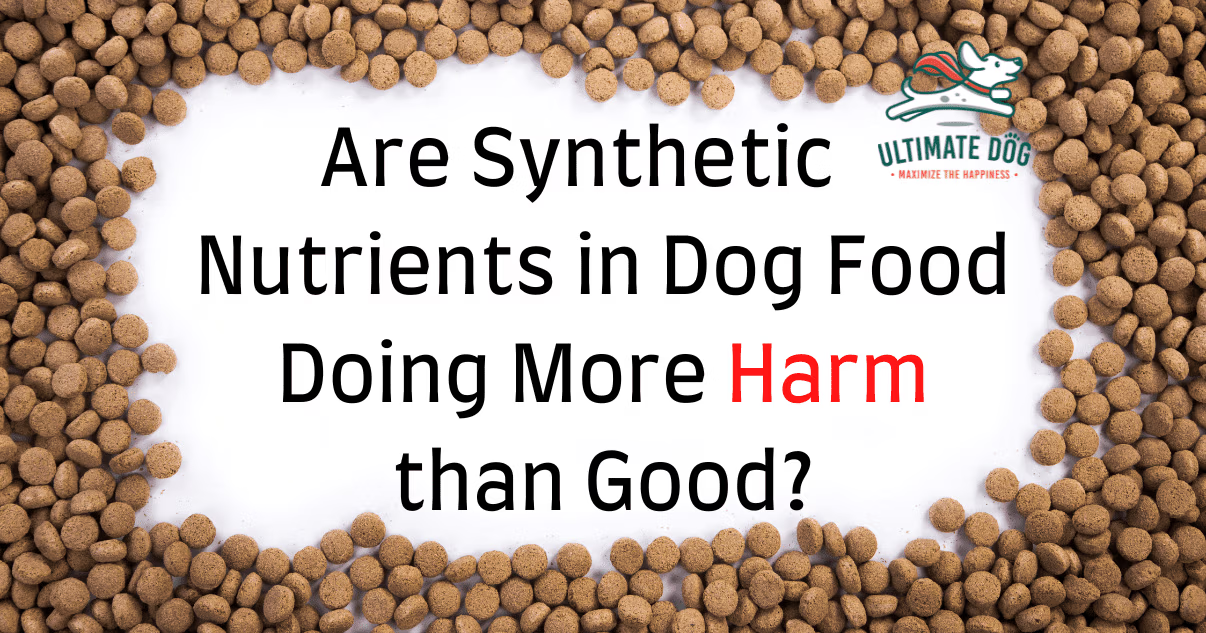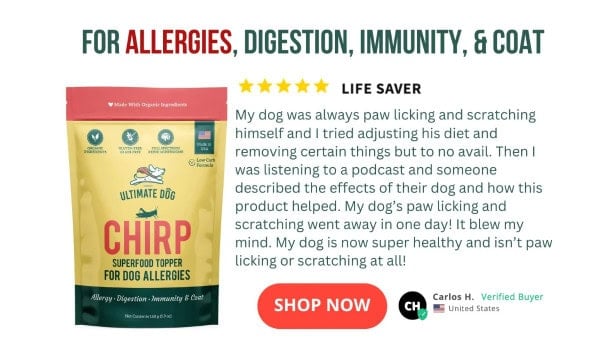If you’ve ever spent some time looking at the dog food nutrition label on your dog’s favorite kibble, you’ve no doubt noticed a long list of added nutrients near the bottom. This may have gotten you wondering why these vitamins and minerals have to be added to dog food.
More importantly, you may be wondering if these synthetic additives are better for your dog than foods that contain only natural whole-food ingredients.
Today, we’re going to dive into that topic. We’ll look at why synthetic nutrients are often added to dog food, what they are, and what problems they may pose. We’ll also dive into how you can avoid these synthetic ingredients and find the healthiest possible food for your four-legged friend.
Why Are Synthetic Nutrients Added to Pet Food?
In order to reach the “complete and balanced” label governed by the Association of American Feed Control Officials (AAFCO), pet food companies must prove that their foods contain certain levels of specific nutrients.
There are two ways to prove a food meets these standards. The first requires extensive testing on the nutritional content of the finished food and further testing to prove biological availability to the animal. The second option simply requires adding a predetermined amount of synthetic nutrients to the recipe.
Given the prohibitive costs associated with the first method, most companies (over 99% of dry and wet food producers) opt for the second option. Not only is this option the cheapest and easiest, but it is also the only one available for the bulk of pet food recipes out there. This is because the type and quality of whole food ingredients used in those recipes don’t come anywhere near meeting the AAFCO nutritional requirements on their own.
In short, synthetic vitamins, minerals, and amino acids are added to dog food because it is the easiest way to meet AAFCO standards and the cheapest way to create a diet with enough nutrients to be considered “complete and balanced.”
A Closer Look at Common Synthetic Vitamins and Minerals
AAFCO offers a prescriptive list of synthetic nutrients that can be added to pet foods in order to meet requirements. For this reason, you’ll often see many of the same synthetic ingredients listed on wet food and kibble nutrition labels.
Here is an example of a typical nutrition label (taken from a popular grocery-store brand dog food). Everything highlighted in yellow indicates a synthetic additive:

How Are These Nutrients Made?
Like synthetic vitamins added to fortified human foods and human supplements, synthetic nutrients in pet foods are used as replacements for naturally occurring vitamins and minerals. Most of these compounds are made in the lab by reacting organic or inorganic substances with acids, bases, or other reducing compounds. Some compounds used to create synthetic vitamins and minerals are less than appetizing.
L-Lysine monohydrochloride, for instance, is made by reacting ammonia, hydrogen cyanide, and mercaptaldehyde. None of these are things you’d want in your food in their raw form.
But the ingredients used to make synthetic nutrients aren’t the real problem. It’s the form these nutrients take that causes issues. Because, when making a synthetic nutrient, it’s not always possible to just add the element the body uses to the food. Instead, a shelf-stable form of that element is usually created. Often, these shelf-stable forms look a lot different from the natural state of that nutrient.
For example, calcium is added to foods most commonly as calcium carbonate or calcium citrate. The latter is absorbed more easily but only contains 21% calcium. The former contains much more calcium but very little of it is absorbed by the body. And both types are affected by the other nutrients they’re consumed with.
Where Problems Arise
Because these nutrients are not always identical to forms found in nature, the body isn’t capable of utilizing them the same. Despite this, synthetic products are generally scored the same way as natural nutrients in terms of meeting regulations, even though they do not necessarily fulfill the same needs in the body.[1]
Here are a few examples using some of the most common synthetic nutrients found in dog food:
- B Vitamins – Synthetic B vitamins have been widely proven ineffective at fulfilling the same role as natural B vitamins in the body. Ingesting only synthetic B vitamins can lead to anemia, paralysis, and stunted growth.
- Menadione Sodium Bisulfite Complex (Vitamin K) – While this synthetic form of vitamin K has shown effectiveness when given as an oral supplement, it rapidly loses its potency when mixed with other ingredients. This loss of potency is not always taken into consideration when determining how much of the vitamin to add to pet food.
- L-Lysine monohydrochloride – This synthetic nutrient is used to deliver the amino acid lysine. But, unlike pure lysine, it comes with byproducts that can quickly reach toxic levels before an adequate amount of lysine is consumed. In pig studies, this additive led to a drastic increase in piglet mortality when used in the sows’ feed.
- Sodium selenite – When consumed in small amounts with the necessary cofactors, selenium is anticarcinogenic and an antioxidant. But when consumed in higher amounts as a synthetic additive, it has been found to cause cancer and inflammation.
There are many more examples of specific synthetic nutrients behaving differently in the body than their natural counterparts. We will look at more of them below.
The Disadvantages of Synthetic Nutrients
While using synthetic additives may be highly beneficial for dog food producers, it does not have the same effect on the canines who eat those diets. From a lack of cofactors to the potential for overdose, fortified dog foods come with a heaping of disadvantages over whole-food recipes.
Lack Cofactors
Cofactors are nutrients and chemical compounds that frequently appear with certain vitamins and minerals in nature. These important substances play a vital role in helping our dogs’ bodies utilize that key nutrient. Without them, the nutrient may not be absorbed, may not be usable, or may cause damage.
Often, how cofactors work to induce nutrient action is not well understood. In fact, in many foods, the cofactors necessary for action cannot be readily identified. This was the case in a study that looked at the use of synthetic B vitamins in puppy food. After some time on the synthetic diet, the puppies developed hair and pigment loss, anemia, low white blood cell count, and lethargy. Attempts were made to add more synthetic vitamins to reverse the ailments, including biotin (a commonly used synthetic form of vitamin B7), but to no avail. The only cures that worked were supplementing with brewer’s yeast or liver—two whole foods naturally high in B vitamins.
Another study looking at the use of synthetic B vitamins in dog diets that were completely void of natural B vitamins found that the synthetic supplements did nothing to prevent ascending paralysis in the test dogs. In fact, the dogs receiving eight types of synthetic B vitamins showed a higher incidence of paralysis than those receiving only seven types. The control group, which was supplemented with natural brewers yeast, showed no incidence of paralysis.
Cause “Peak and Drop” Phenomenon
Another common problem people and dogs experience with synthetic nutrients is something we’re calling “peak and drop” phenomenon. This strange occurrence has been recorded in many nutrient studies. It consists of an initial improvement in symptoms caused by nutrient deficiency, followed by a sudden recurrence of symptoms.
This trend is attributed to the tendency of synthetic vitamins and minerals to attach to cell receptors and activate normal responses initially. This period of normal recovery is followed by the inability to fully clear the receptor once the nutrient has been utilized. This results in “clogged” cells that can no longer take in more of the synthetic vitamin or mineral, leading to a reappearance of symptoms.
One great example of this phenomenon occurred in a study looking at B6 deficiency anemia in dogs. Two groups of test canines were given various mixes of synthetic B vitamins. The two control groups were given either brewers yeast alone or brewers yeast with the synthetic B vitamin mix. The two test groups showed an initial uptick in hemoglobin levels followed by a drastic decline into anemia. The two control groups showed a minor uptick in hemoglobin followed by sustained normal levels through the rest of the experiment.
Interestingly, one of the test dogs that declined into severe anemia was treated with synthetic B6. But when this failed to reverse the problem, he was put on brewer’s yeast, at which point he made a full recovery.
Cause Side-Effects Not Seen in Whole Food Nutrients
Both a lack of necessary cofactors and issues associated with peak and drop phenomena can lead to unexpected side effects that synthetic nutrients have and natural nutrients do not. To make matters worse, many of the AAFCO nutrient guidelines include minimum amounts but not maximums.
Synthetic nutrients already have the potential to cause adverse reactions. When these nutrients are included in diets in higher than optimal amounts, the likelihood—and severity—of these side effects only increases.
In fact, there have been many recalls of dog foods that contain toxic levels of synthetic additives. The most famous of these came after dogs started dying of vitamin D toxicity. This vitamin happens to be one of a few that does have a maximum limit set by AAFCO. If a nutrient that does not have this testable maximum is overused in a recipe, it is much less likely that a recall would be issued, even if dogs became ill.
Nutrients with listed maximums are those most likely to cause death if over-ingested. But many of the nutrients without maximums are also known to cause health issues, including diarrhea, stomach upset, and neurological problems.
Because natural nutrients only exist in certain amounts in whole foods, overdose is much less likely. The dog would likely react to other substances in the food and vomit long before enough of any one nutrient was ingested to cause harm. More importantly, these nutrients come with cofactors that help regulate their use in the body and reduce side effects.
Only Part of the Picture
One of the biggest drawbacks of utilizing synthetic nutrients is that they represent only a small piece of the overall nutritional picture we should be looking at when feeding our pets. This is true in many respects.
There are plenty of substances that are beneficial to dog health, like glucosamine and probiotics. But these and others are not required by AAFCO. And, consequently, most dog foods do not contain them despite overwhelming evidence of their benefits.
AAFCO uses only two requirement categories for dog food; those meant for growth and reproduction (puppy food) and those meant for adult dogs. But dogs have different nutritional needs at many stages in their lives. Older dogs often require more of certain nutrients to support their systems. Intact dogs need different nutrient amounts than fixed dogs. And animals battling an injury or ailment can benefit from different nutrient concentrations in their diets (not necessarily prescription diets, though).
Additionally, there have been many instances of interactions within dog food recipes leading to changes in nutrient absorption. Most recently, this phenomenon made national news after hundreds of dogs not prone to dilated cardiomyopathy developed the condition. The FDA released a warning citing diets containing legumes and potatoes as the most likely cause. Why? Because something in these diets is reducing the absorbability or usefulness of the amino acid taurine. The same thing happened a few decades ago in pets eating lamb and rice recipes.
The potential for dog food ingredients to limit or affect the level of usable synthetic nutrients is well documented. One study found that corn grits (which are often used in dog and puppy food) severely limited the use of niacin and led to growth stunting in test puppies. In order to overcome this, three times the recommended amount of nicotinic acid had to be added to the diet before growth normalized.
We are gaining new knowledge about how nutrients affect and support the body every day. The standard dose of synthetic nutrients is a snapshot from this understanding that doesn’t change often enough to account for our changing knowledge on the subject of dog nutrition. And is not enough to ensure that any food is “complete” or “balanced.”
How Can You Escape Synthetic Vitamins in Dog Food?
At best, synthetic nutrients allow dog food companies to meet the bare minimum for nutritional quality. At worst, they impart dangerous side effects and leave your dog deficient in essential vitamins, minerals, and amino acids.
But how do you avoid synthetic vitamins and minerals while providing food that meets your dog’s nutrient requirements?
Commercial products are one option, but those that fit these requirements are hard to find.
Because kibble requires heat and pressure processing that destroys nutrients, it is very difficult to find dry dog food that hasn’t been fortified. You’re much more likely to find these options in the freeze-dried, air-dried, and dehydrated diet aisle. Not all of these are synthetic vitamin and mineral free, but all contain far more natural nutrients than kibble.
Raw food is your best bet for additive-free food in the commercial category. But even many of these diets contain some synthetic vitamins or minerals to fill the gaps of what the whole food ingredients don’t provide enough of.
If you want to completely avoid synthetic additives, you almost have to make your own dog food at home. Whether you do this using raw food or freshly cooked ingredients, you will likely need to add some nutrient-dense supplements to provide everything your dog needs. Be sure these supplements don’t just add back in the synthetic ingredients you’re trying to avoid. Look for additions and toppers that are made with 100% whole-food, nutrient-dense ingredients.
Sources
Center for Veterinary Medicine. (2019, June 27). FDA Investigation into Potential Link between Certain Diets and Canine Dilated Cardiomyopathy. U.S. Food And Drug Administration.
Frost, D. V., & Dann, F. P. (1944). Unidentified Factor(s) in Yeast and Liver Essential to Cure of Achromotrichia in Dogs on Synthetic Diets. The Journal of Nutrition, 27(5), 355–362.
Krehl, W. A., Teply, L. J., & Elvehjem, C. A. (1945). Effect of Corn Grits on Nicotinic Acid Requirements of the Dog. Experimental Biology and Medicine, 58(4), 334–337.
NOSB Materials Database. (2007, October 12). Amino Acids: Processing. USDA.gov. Retrieved December 7, 2022.[2]
Perdue, H. S., Spruth, H. C., & Frost, D. V. (1957). Comparison of Vitamin K Activities of Vitamin K1 and Klotogen (Menadione Sodium Bisulfite Complex). Poultry Science, 36(3), 633–635.
Pet Food Report 2013 Midyear-Proposed Revisions to AAFCO Nutrient Profiles. (2012). AAFCO. Retrieved December 6, 2022.
Smith, S. G., Curry, R., & Hawfield, H. (1943). Vitamin B6 Deficiency Anemia in the Dog. Science, 98(2554), 520–522. Touchette, K. J., Allee, G. L., Newcomb, M. D., & Boyd, R. D. (1998). The use of synthetic lysine in the diet of lactating sows. Journal of Animal Science, 76(5), 1437.

Sara Seitz worked in the pet industry for over a decade. In addition to being a certified dog trainer, Sara gained experience working as the general manager of a dog daycare and boarding facility, as the creator and manager of a pet sitting company, as a groomer, and as a dog behavior evaluator. She also has a bachelors in animal behavior from CSU. Currently, Sara works as a freelance writer specializing in blog, article and content writing.




Leave a Comment